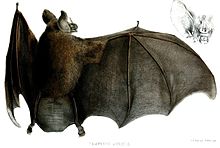- Big-eared Woolly Bat
-
Big-eared Woolly Bat 
Conservation status Scientific classification Kingdom: Animalia Phylum: Chordata Class: Mammalia Order: Chiroptera Family: Phyllostomidae Genus: Chrotopterus Species: C. auritus Binomial name Chrotopterus auritus
Peters, 1865The Big-eared Woolly Bat (or (Peter's) Woolly False Vampire Bat), Chrotopterus auritus, is a bat species native to Central and South America, where it is found from southern Mexico to northern Argentina, Paraguay and southern Brazil. It is monotypic within its genus.
They are large predatory bats, the second largest bat species in the neotropics, and feed on fruits, beetles, moths, lizards, small mammals (including opossums and rodents), birds (including passerine birds) and other bat species. They can take prey of up to 70 g weight, but usually feed on smaller vertebrates of 10 to 35 g.
This bat species lives in warm subtropical forests, usually roosting in caves and hollow logs where they, sometimes, bring their prey to eat. Sometimes they cannot be found in disturbed forests.
Big-eared Woolly Bats fly slowly, partially because of their size, flying at 1 or 2 meters above ground and usually in dense thickets. They give birth to a single young after a gestation period of more than 100 days. Colonies size vary between one to seven individuals, consisting of a male-female adult pair and young(s).
References
- Chiroptera Specialist Group 1996. Chrotopterus auritus. 2008 IUCN Red List of Threatened Species. Downloaded on 26 October 2008.
- Theodore H. Flemming, 2003. A Bat Man in the Tropics: Chasing El Duende.
- Eisenberg, J.F. and Redford, K.H. 1999. "Mammals of the Neotropics, Volume 3: The Central Neotropics: Ecuador, Peru, Bolivia, Brazil". University of Chicago Press.
- Louise H. Emmons and François Feer, 2000. Neotropical Rainforest Mammals.
Categories:- IUCN Red List least concern species
- Mammals of Central America
- Bats of South America
- Mammals of Guyana
- Phyllostomidae
- Mammals of Costa Rica
Wikimedia Foundation. 2010.
Look at other dictionaries:
Big-eared Wooly Bat — Taxobox name = Big eared Woolly Bat status = LR/lc | status system = IUCN2.3 regnum = Animalia phylum = Chordata classis = Mammalia ordo = Chiroptera familia = Phyllostomidae genus = Chrotopterus species = C. auritus binomial = Chrotopterus… … Wikipedia
Brosset's Big-eared Bat — Conservation status Data Deficient (IUCN 3.1)[1] … Wikipedia
Hairy Big-eared Bat — Conservation status Least Concern (IUCN 3.1) Scientific classification Ki … Wikipedia
Matses' Big-eared Bat — Conservation status Data Deficient (IUCN 3.1) Scientific classification … Wikipedia
Little Big-eared Bat — Conservation status Least Concern (IUCN 3.1)[1] … Wikipedia
Common Big-eared Bat — Conservation status Least Concern (IUCN 3.1) Scientific classification K … Wikipedia
White-bellied Big-eared Bat — Conservation status Least Concern (IUCN 3.1) Scientific classification … Wikipedia
Sanborn's Big-eared Bat — Conservation status Data Deficient (IUCN 3.1) Scientific classification … Wikipedia
Schmidts's Big-eared Bat — Conservation status Least Concern (IUCN 2.3) Scientific classification … Wikipedia
Least Big-eared Bat — Conservation status Vulnerable (IUCN 3.1)[1] … Wikipedia

